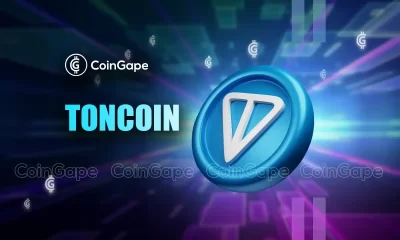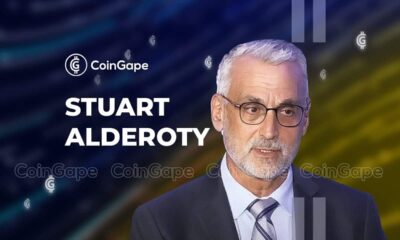Adoption
Museums, AI-generated art, blockchain, and NFTs
Published
2 months agoon
By
admin

Disclosure: The views and opinions expressed here belong solely to the author and do not represent the views and opinions of crypto.news’ editorial.
Refik Anadol Studio, co-founded by Refik Anadol and Efsun Erkiliç in 2025, is launching an immersive AI art & NFT museum called DATALAND at The Grand LA, with a flagship location at the Frank Gehry-designed development in the heart of downtown Los Angeles.
DATALAND will feature immersive AI art experiences by establishing a new model for artistic expression at the onset of the digital age by taking immersion to the next level with the AI-powered scent of the galleries. As AI artist Refik Anadol explained to me:
“We aren’t yet revealing the details about DATALAND’s artistic programming, but there will be many moments for sharing/exhibiting AI artists’ work both physically and virtually so people who cannot travel to LA have access to the AI art creations. And can purchase the AI art work NFTs minted on an Ethereum-based platform and many other sustainable chains for exciting art and culture activities.”
Refik Anadol Studio announced the launch of DATALAND during Climate Week NYC, which is celebrated NYS-wide for the first time and runs parallel to the United Nations General Assembly meeting, where world leaders gather to address critical global challenges. DATALAND’s inaugural exhibitions will be prepared with the Large Nature Model, an open-source AI model based solely on nature data, to produce unprecedented immersive AI-powered digital environmental artwork. The studio initially presented such installations at the 2024 World Economic Forum in Davos, Switzerland, and then at the United Nations in New York during the 2024 UNGA to promote environmental awareness. As UN Under-Secretary-General Melissa Fleming concurred:
“Refik Anadol’s artwork is a testament to the beauty and fragility of our natural world. It’s a clarion call to world leaders: we must harness the power of technology [AI art & NFTs] and human ingenuity and agency to incite action to protect our planet before it’s too late.”
The award-winning studio has been engaged by leading tech companies, groundbreaking researchers, and cutting-edge thought leaders to produce projects that have been shown in more than 70 cities spanning six continents and experienced by millions of ardent fans. These exhibition venues include several United Nations Climate Change Conferences, MoMA, Centre Pompidou-Metz, Serpentine Galleries, National Gallery of Victoria, Venice Architecture Biennale, Hammer Museum, Arken Museum, Casa Batlló, Dongdaemun Design Plaza, Daejeon Museum of Art, and Istanbul Modern Museum. Nevertheless, Refik Anadol Studio, as explained by Refik, chose “Los Angeles as the perfect city to launch DATALAND, a forward-thinking, revolutionary museum in support of the fields to which I have dedicated my career: art, science, technology, and AI research.” And he continued:
“As LA has long been a city that looks to the future in art, music, cinema, architecture, and more, it feels natural to open DATALAND here. To have a permanent space for us to develop a new paradigm of what a museum can be—by fusing human imagination with machine intelligence and the most advanced technologies available—is a realization of one of my biggest dreams. To do so in a building designed by one of my heroes, Frank Gehry, is almost unbelievable.”
DATALAND will use millions of photos and other records from partner museums, including the Smithsonian and London’s Natural History Museum, to create its installations. “We already have three major collaborations with museums in the works and are very confident to join forces across the world,” added Refik.
History of AI art, NFTs, and museums
Christiane Paul, the digital art curator of Whitney Museum, who is “looking forward to learning more about DATALAND,” detailed the AI Art History at the groundbreaking symposium at Rhode Island School of Design’s “Debates in AI” held during April 11-12, 2024, that invited artists worldwide. She explained that AI art has a fascinating history that intertwines technology and creativity, and it continues to evolve, pushing the boundaries of what is possible at the intersection of technology and creativity.
Christiane Paul, curator of Digital Art at Whitney Museum, debates in AI art history
Early beginnings: 1950s-1970s. The roots of AI art can be traced back to early experiments with computer-generated art, where artists and computer scientists collaborated to create visual and abstract compositions using early computer algorithms. One notable example from this era is captured by the Whitney Museum’s exhibition curated by Christiane Paul with David Lisbon tracing the evolution of Harold Cohen’s AARON, the earliest artificial intelligence program designed to create drawings and paintings. AARON was first exhibited in 1972 at the Los Angeles County Museum of Art.
Advancements in algorithms: 1980s-2000s. During this period, algorithms and computing power advancements allowed for more complex and varied artistic outputs, and AI art began to gain recognition in academic and artistic circles.
The city of Los Angeles, which will become home to DATALAND, served as grounds for the Gray Area Foundation, a cultural incubator with a mission to cultivate, sustain, and apply antidisciplinary collaboration, back in 2002 to integrate art, technology, science, AI, and the humanities—towards a more equitable and regenerative future. This foundation moved its headquarters to San Francisco in 2005.
Deep learning revolution: 2010s. The advent of deep learning brought significant changes with generative adversarial networks and other machine learning techniques that enabled the creation of highly sophisticated and realistic artworks. AI art started to be exhibited in NFT form in galleries and museums and auctioned in prominent auction houses, raising questions about creativity and authorship.
In 2014, digital artist Kevin McCoy issued the first-ever art NFT.
Four years later, in 2018, Christie’s art auction house became the first auction house ever to offer AI artwork for sale. Christie’s also hosted its first Art + Tech Summit on the topic of blockchain. In June 2019, the second edition focused on artificial intelligence and art. Since then, blockchain, NFTs, and AI have been hot topics in the art world, intersecting unexpectedly. At the helm of digital curator Christiane Paul, Whitney Museum became an early collector of NFTs starting in 2018.
Mainstream adoption: 2020s. The increased availability of AI art tools to the general public has democratized the creation of AI-generated images. This era has also seen debates about NFTs, its market bubble and crash, copyright, the impact on traditional artists, and the ethical implications of AI in art.
In Germany, the Intelligent Museum—a practice-based research and development project at the ZKM | Center for Art and Media Karlsruhe and the German Museum—was backed by the Digital Culture Programme of the German Federal Cultural Foundation in 2020. It explores new paths of museum communication and outreach to connect the museum with current AI technologies, making it a place of experience and experimentation, a social space where art, science, technology, and public discourse come together. One of the best-selling AI-generated NFT artists exhibited at ZKM is a program called Botto, which is the brainchild of computer engineers and a German artist named Mario Klingemann in 2021 that creates AI art NFTs. Today, Botto has created over 75 NFTs that generated more than $3 million in revenue.
In New York City, the Museum of Modern Art—ahead of holding its first-ever AI Art Show curated by Michelle Kuo, “Unsupervised” by Refik Anadol—became the beneficiary of a major new endowment established by the William S. Paley Foundation to support MoMA’s ambitious goals in digital media and technology and to provide for new AI Art/NFT acquisitions. Henry Kissinger, Chairman of the William S. Paley Foundation at the time, stated:
“I know how deeply my friend Bill Paley cared about The Museum of Modern Art and with what devotion he dedicated himself to its advancement. With this initiative, the Foundation will honor his intention and continue his vision for MoMA.”
Nevertheless, MoMA has adopted a cautious approach to NFTs so far. Other than contributing data to algorithmically generated works by artist Refik Anadol and, in October 2023, announcing that it had acquired “Unsupervised” for its permanent collection, the museum has not been involved with other AI art or NFT projects.
In Singapore, curated by ArtScience Museum’s Deborah Lim and guest curator Clara Che Wei Peh, “Notes From the Ether” last year was an exciting and timely exhibition that offered a glimpse into the future of digital art with work by 20 artists: Memo Akten, Burak Arikan, Botto, Mitchell F Chan, DEAFBEEF Simon Denny, Harm van den Dorpel, Sarah Friend, Rimbawan Gerilya, Holly Herndon and Mathew Dryhurst, Tyler Hobbs and Dandelion Wistjo+kapi, Larva Labs, Jonas Lund, Ninaad Kothawade, Sarah Meyohas, Rhea Myers, Aaron Penne, Aluan Wang, Emily Xie. These artists work with the emerging technologies of non-fungible tokens and generative artificial intelligence to push the boundaries of what art is and what it could be.
The future of museums AI art and NFTs
Undoubtedly, over the past 40 years, the usage of AI-generated art has been on the rise, becoming all the more popular during the last ten years with the tokenization of art via NFTs, according to the Academy of Animated Art. As Vilas Dhar, President of the Patrick J. McGovern Foundation, explained:
“AI is not just a tool for innovation—it’s a force that can reshape how we see our planet, reconnecting us with the beauty and fragility of nature in ways never before possible. Refik Anadol’s brilliant vision allows us to use technology [AI Art & NFTs] to engage the senses and spark a deeper emotional connection to our natural world.”
During this year, many museums and more than 100 “immersive” institutions around the world are showcasing/purchasing AI art and NFTs on a large scale to massive audiences to exhibit the marriage of human imagination and machine intelligence, which includes Seattle NFT Museum, Guggenheim Museum, Mercer Labs, Museum of Art & Light, Buffalo AKG Art Museum, Centre Pompidou, Tate Modern, PST Art: Art & Science Collide, which held at over 60 shows across Southern California, and many others.
Magda Shawon, co-founder of Postmasters Gallery in New York City, who works with the first NFT Artist Kevin McCoy, has been selling digital, AI-generated art to museums such as MoMA, the Metropolitan Museum of Art, and The Whitney Museum of American Art for over 20 years. She agrees with Vilas and Melissa’s sentiments about Refik’s impactful AI artwork:
“People don’t want to stop watching Refik Anadol’s AI Work when they sit in front of it. Refik’s work has an impact, but whether it is a trigger to create an enormous field of AI generative art, NFT sales is a big question.”
Digital art has been collected for as long as it has existed, but widespread adoption is still nascent. The tokenization of art via NFTs has helped the digital art world and the traditional art world integrate, leading to a burgeoning interest from museums, immersive institutions, collectors, auction houses, NFT markets, and galleries. The first NFT artist, Kevin McCoy, who created an art NFT back in 2014, is hopeful and supports Refik’s museum, AI art, and NFT initiative. He highlighted:
“I’m heartened by Anadol’s announcement of Dataland. He is leading by example both with his ‘ethical AI’ initiative and the commitment to the exhibition and preservation of AI and digital art that the museum represents. Within this context, the provenance provided by NFTs and blockchain-based records, more generally, can play a central role. This will be an important next step in the expanding use of this technology.”
Source link
You may like


Senator Lummis wants to replenish Bitcoin reserves with gold


Will Toncoin Price Hit $10 After Recent 20% Rally?


AI Crypto Startup O.XYZ Faces Allegations of Misrepresentation and Internal Turmoil: Sources


Gensler to resign as SEC chair: What’s next under Trump?


Ripple Provided The Blueprint To Defeat Gary Gensler


Another U.S. SEC Democrat to Drop Out, Leaving Republicans Running Agency by February
Adoption
AI startup Genius Group picks Bitcoin as main treasury asset
Published
2 weeks agoon
November 12, 2024By
admin

Bitcoin as an institutional reserve asset gained more traction as a Singapore-based AI company took a page from MicroStrategy’s book.
Per a press statement, publicly-traded artificial intelligence firm Genius Group will onboard Bitcoin (BTC) as its main treasury holding and immediately purchase $120 million worth of the world’s leading cryptocurrency.
Genius Group also said it would hold 90% of its current and future treasury value in Bitcoin, adding to its initial 1,380 token buy plan disclosed on Nov. 12. The startup’s GNS shares surged 50% during pre-market trading, according to Yahoo Finance. GNS prices shook off gains by publishing time, but the shares still traded higher than their previous close.
At least three institutional players have now adopted the BTC accumulation strategy pioneered by Michael Saylor’s software behemoth MicroStrategy. Firms like Tokyo’s Metaplanet, medical tech provider Semler Scientific, and now Genius announced BTC purchasing plans inspired by Saylor’s company.
All three companies hold over 1,000 BTC. The trio were leagues away from MicroStrategy’s 279,420 Bitcoin trove valued at over $24 billion due to recent highs.
We believe that with our Bitcoin-first strategy, we will be among the first NYSE American listed companies to fully embrace Microstrategy’s Bitcoin strategy for the benefit of our shareholders.
Thomas Power, Genius Group director
Stocking most of its treasury with BTC was also revealed shortly after Genius reshuffled its top decision-makers. Genius added multiple crypto-savvy board members as the firm paid more attention to web3 and blockchain technology.
Source link
Adoption
Crypto wins the vote in the 2024 US elections
Published
3 weeks agoon
November 3, 2024By
admin
Disclosure: The views and opinions expressed here belong solely to the author and do not represent the views and opinions of crypto.news’ editorial.
The 2024 US election campaigns have been a masterclass in how to compel a large group of people to elect their country’s leaders. In a short time, we’ve seen sentiments shift after each candidate began their campaign trails and made promises to voters surrounding issues such as immigration, cost of living, and reproductive rights.
From spreading memes about migrants eating cats and dogs and the humorous “coconut tree” remark to the decisive role of lobbying regulators, the similarities between pushing political messaging and crypto narratives are difficult to ignore.
Crypto is no stranger to compelling messages. One of the most memorable phrases in crypto history, “The Times 03/Jan/2009 Chancellor on the brink of second bailout for banks,” contained in Bitcoin’s (BTC) genesis block, is a reminder of the powerful messaging that has helped propel the industry forward. For crypto to win the “people’s vote” again, the industry can learn from several foundational communication principles we observed in this year’s elections.
Tapping into the psyche of the masses with memes
The use of memes in political messaging this election cycle has helped candidates engage the voter base and shift their perceptions.
In July, singer Charli XCX took to her almost 3.7 million followers on X to endorse Kamala Harris with a three-word X-post, “kamala IS brat.” Brat was an album launched by Charli XCX, with notable colors of neon lime green and black. The Harris campaign quickly adopted the theme into their campaign color scheme, resulting in the “Kamala is brat” meme exploding across the web and TikTok, introducing a new cultural reference that positively shaped discourse. This is particularly significant for young and new voters who are increasingly getting their news through social media, according to Pew Research.
Originating from evolutionary biology, memetics, the study of memes explores how ideas, behaviors, and cultural phenomena spread. The light-heartedness of the medium allows people to digest complex or unsettling political realities in a more approachable way, impacting voter attitudes at an emotional level.
Crypto has seen its successful application through memecoins like Dogecoin (DOGE), Shiba Inu (SHIB), and Dogwifhat (WIF), which leverage meme culture to build communities and hype. Similar to political memes spreading ideology, memecoins spread economic narratives through humor and social media engagement.
The overall industry needs to see a return to memes that captivate users broadly. Popular memes like ‘diamond hands,’ ‘WAGMI’ (we’re all gonna make it), and HODL (hold on for dear life) have in the past spread beliefs about crypto like wildfire. The industry needs to craft new memes and leverage new moments to maintain its relevance and resonate with broad audiences again.
The use of emotional and purpose-driven messaging
Political campaigns also provide examples of how emotionally resonant, purpose-driven language connects with supporters.
Donald J. Trump’s campaign used many bold statements of purpose that studies show resonate with themes of strength and patriotism. Among the most popular is the campaign’s “Make America Great Again” (MAGA) message. His appeal is connected to the psychological readiness in the US culture for an antihero figure, who represents someone bold and unconstrained by typical political decorum and the willingness to challenge the status quo. This was symbolized in Trump’s call to “fight, fight, fight!” that spread following the assassination attempt in July.
The web3 parallel is the need to evoke purpose when speaking to end-users by bypassing complex jargon in favor of emotionally engaging language. Mert Mumtaz, CEO of Helius Labs, a key crypto opinion leader, uses direct and emotionally engaging messaging to resonate with crypto enthusiasts. His commentary, which centers around key trends and recent events, enhances his credibility as a key spokesperson for Solana (SOL) and blockchain tech broadly.
Similarly to how political campaigns use soundbites that reflect the core values of the voter, web3 projects and founders need to rely more on using memorable statements that create an emotional connection, creating greater buy-in from a wider audience.
Lobbying to engage policymakers more seriously
Lobbying played a notable role in this year’s elections. The health of US citizens became an issue that rose in prominence when health lobbyist Calley Means reconnected Republican and independent presidential candidates Donald Trump and Robert F. Kennedy Jr. This played a part in RFK dropping out of the race to support Trump’s campaign, catalyzing the MAHA (Make America Healthy Again) movement and may make a difference in the final election outcome.
The US crypto industry itself has experienced regulatory hostility towards companies after the FTX collapse. Since then, there has been a growing realization that the use of money in politics is simply the way the system operates. Lobbying is needed for the industry’s priorities to be heard in the halls of Congress.
The last two years saw a major uptick in advocacy efforts for better US crypto policy. As of mid-October, crypto-focused super PACs (political action committees) had spent over $134 million to persuade voters to elect Congress members who support crypto. Just this week, the CEO of Coinbase, Brian Armstrong, announced the company was committing an additional $25 million to support the Fairshake PAC leading up to the 2026 midterms to elect pro-crypto candidates.
A continuation of this strategy by US companies could lead to significant shifts in US policy and could see better reception of crypto by users locally, with a ripple effect globally.
The 2024 US elections were littered with examples of masterful communication tactics that can be adopted by crypto projects. As the focus of the industry begins shifting from infrastructure development to the growth of consumer applications across various verticals, these strategies will be increasingly important in persuading users about why they should choose the products offered instead of the many other alternatives available to them.

Debra Nita
Debra Nita is the associate director and head of growth at YAP Global, a crypto-native PR firm. With over a decade of strategic communications and product marketing experience, Debra helps leading crypto and web3 projects gain publicity and build their reputation through top-tier media coverage, leadership, and narrative development. Her expertise includes layer-1 blockchains, rollups, decentralized finance, zero knowledge and cryptography, and stablecoins. Debra has also been a speaker and hackathon judge at leading crypto conferences, including ETHDenver, Mainnet in NYC, ETHToronto, and ETH Kuala Lumpur.
Source link
Adoption
Algoz taps Wincent to streamline its fiat-to-crypto onboarding process
Published
3 weeks agoon
October 30, 2024By
admin

Digital asset investment firm Algoz has announced a strategic collaboration with regulated market maker and top over-the-counter desk Wincent.
Algoz shared details of the new partnership via a press release sent to crypto.news on Oct. 30. This announcement follows Algoz’s recent collaboration with Standard Chartered-backed Zodia Custody.
According to the announcement, Algoz will leverage its partnership with Wincent to facilitate the onboarding of new investors. Through this collaboration, investors such as family offices seeking to enter the crypto market via Algoz will not need to convert fiat currencies to crypto beforehand, as is typical across many providers in the industry.
Wincent offers the solution to this hurdle. Algoz users can now invest using Tether (USDT) Bitcoin (BTC) and Ethereum (ETH) and other cryptocurrencies using U.S. dollars, euros, or other fiat currencies. The partnership allows Algoz clients to directly swap fiat for crypto, reducing risks associated with exposure to unregulated providers.
Algoz noted that its collaboration with Wincent supports asset conversion based on already approved know-your-customer and anti-money laundering checks. These regulatory requirements are critical components of global crypto regulation, with various industry players viewing them as essential to the growth of the crypto market.
With regulatory clarity pivotal to the industry, many players are implementing measures to ensure safe on- and off-ramping of customers. Regulated platforms like Wincent and institutional-backed providers like Zodia Custody contribute to this approach.
The platform’s off-exchange settlement solution, Quant Pro, plays a central role in the partnership.
For Algoz, the solution, Zodia’s custody wallet, and Wincent’s know-your-customer and anti-money laundering integration add a layer of protection for users.
“The creation of Quant Pro, our off-exchange settlement system, using Zodia was the first breakthrough for investors as we were able to significantly mitigate exchange and management counterparty risk.”
Stephen Wundke, director of strategy and revenue at Algoz.
Wincent’s regulated market records between $3 and $5 billion in daily volume, with over 300,000 daily transactions.
Source link

Senator Lummis wants to replenish Bitcoin reserves with gold

Will Toncoin Price Hit $10 After Recent 20% Rally?

AI Crypto Startup O.XYZ Faces Allegations of Misrepresentation and Internal Turmoil: Sources

Gensler to resign as SEC chair: What’s next under Trump?

Ripple Provided The Blueprint To Defeat Gary Gensler

Another U.S. SEC Democrat to Drop Out, Leaving Republicans Running Agency by February

Catzilla vs Cardano vs TRX for year-end success

Will Polkadot Price Continue To Rally Following 100% Surge?

Dogecoin, Shiba Inu set the trend; this altcoin is ready to take the spotlight next

This Analyst Correctly Predicted The Bitcoin Price Jump To $99,000, But His Prediction Is Not Done

Analyst Who Accurately Predicted Solana Price Rally Shares Next Target

NFT sales drop 9.6% to $160.9m, Ethereum and Bitcoin network sales plunge

SHIB Lead Shytoshi Kusama Hints At TREAT Token Launch

Trader Says Top-10 Altcoin To Vastly Outperform Bitcoin and Ethereum, Hit New Record High Quicker Than Expected

5 tokens to consider buying today
182267361726451435

Why Did Trump Change His Mind on Bitcoin?

Top Crypto News Headlines of The Week

New U.S. president must bring clarity to crypto regulation, analyst says

Ethereum, Solana touch key levels as Bitcoin spikes

Will XRP Price Defend $0.5 Support If SEC Decides to Appeal?

Bitcoin Open-Source Development Takes The Stage In Nashville

Bitcoin 20% Surge In 3 Weeks Teases Record-Breaking Potential

Ethereum Crash A Buying Opportunity? This Whale Thinks So

Shiba Inu Price Slips 4% as 3500% Burn Rate Surge Fails to Halt Correction

‘Hamster Kombat’ Airdrop Delayed as Pre-Market Trading for Telegram Game Expands

Washington financial watchdog warns of scam involving fake crypto ‘professors’

Citigroup Executive Steps Down To Explore Crypto
Mostbet Güvenilir Mi – Casino Bonus 2024

Bitcoin flashes indicator that often precedes higher prices: CryptoQuant
Trending

 2 months ago
2 months ago182267361726451435

 Donald Trump4 months ago
Donald Trump4 months agoWhy Did Trump Change His Mind on Bitcoin?

 24/7 Cryptocurrency News3 months ago
24/7 Cryptocurrency News3 months agoTop Crypto News Headlines of The Week

 News3 months ago
News3 months agoNew U.S. president must bring clarity to crypto regulation, analyst says

 Bitcoin4 months ago
Bitcoin4 months agoEthereum, Solana touch key levels as Bitcoin spikes

 Price analysis3 months ago
Price analysis3 months agoWill XRP Price Defend $0.5 Support If SEC Decides to Appeal?

 Opinion4 months ago
Opinion4 months agoBitcoin Open-Source Development Takes The Stage In Nashville

 Bitcoin4 months ago
Bitcoin4 months agoBitcoin 20% Surge In 3 Weeks Teases Record-Breaking Potential


